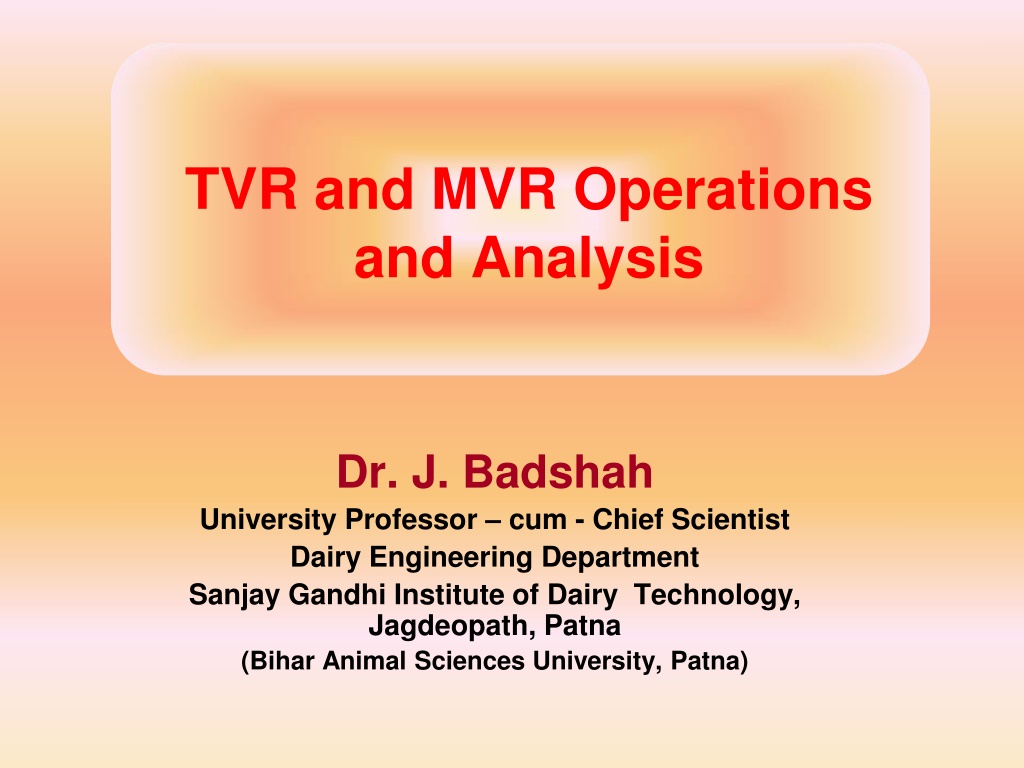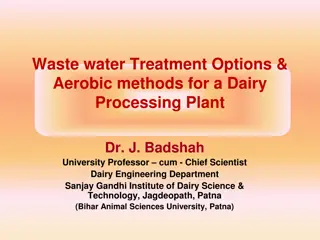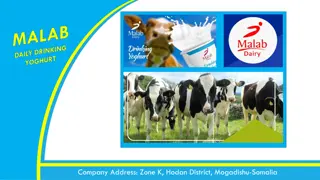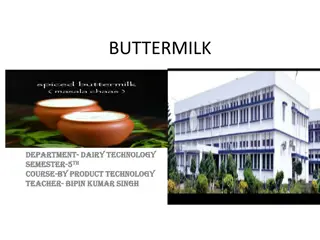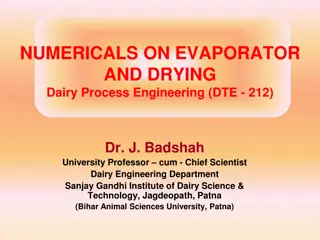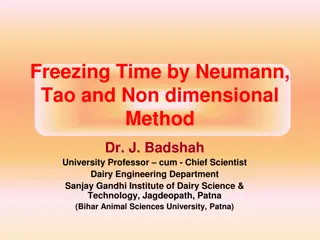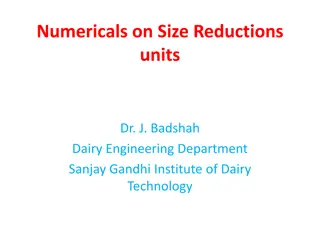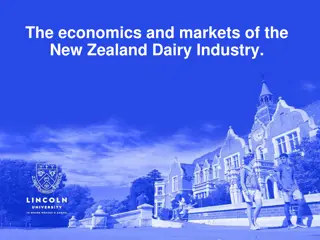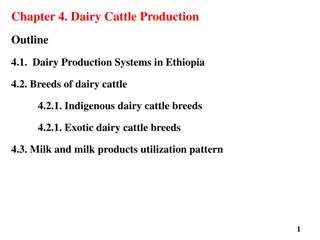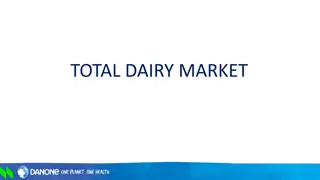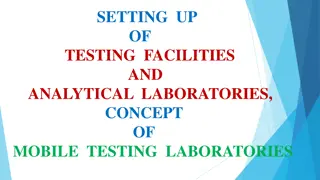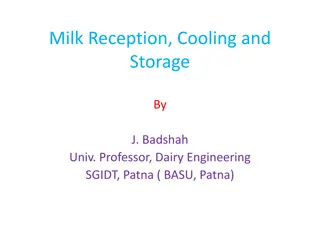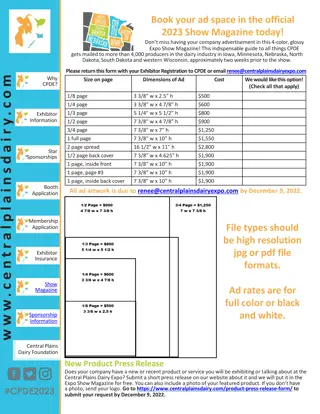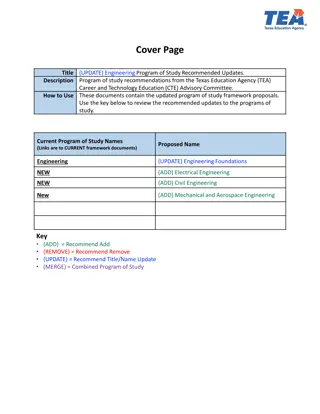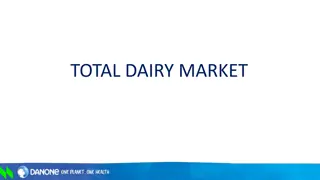TVR and MVR Operations and Analysis in Dairy Engineering
TVR (Thermo Compressor Vapour Recompression) and MVR (Mechanical Vapour Recompression) are two methods used in dairy engineering to compress vapors for various processes. TVR utilizes the kinetic energy of steam jets while MVR employs mechanical compression through compressors. The advantages and disadvantages of both methods are discussed, highlighting aspects such as flavor recovery, design simplicity, investment costs, energy requirements, and space utilization. Illustrations and diagrams further elucidate the functioning of these systems.
Download Presentation

Please find below an Image/Link to download the presentation.
The content on the website is provided AS IS for your information and personal use only. It may not be sold, licensed, or shared on other websites without obtaining consent from the author.If you encounter any issues during the download, it is possible that the publisher has removed the file from their server.
You are allowed to download the files provided on this website for personal or commercial use, subject to the condition that they are used lawfully. All files are the property of their respective owners.
The content on the website is provided AS IS for your information and personal use only. It may not be sold, licensed, or shared on other websites without obtaining consent from the author.
E N D
Presentation Transcript
TVR and MVR Operations and Analysis Dr. J. Badshah University Professor cum - Chief Scientist Dairy Engineering Department Sanjay Gandhi Institute of Dairy Technology, Jagdeopath, Patna (Bihar Animal Sciences University, Patna)
TVR In thermo compressor, the kinetic energy of a jet of steam is used to compress the vapour. It consists of a steam nozzle, suction chamber with inlet for sucking in the vapour, mixing chamber and recompression chamber. The live steam at pressure P1(state-1) is almost isentropically expanded in the nozzle to suction pressure P2(state-2). Steam pressure usually employed in the condensing plant is about 8-12 bar and suction pressure about 0.2-0.3 bar depending on the effect from which the vapour is drawn. The expanded steam emerges from the nozzle as a jet of steam. The velocity of the steam is about 1000 m/sec. Fig. 7.3 Enthalpy entropy diagram of thermal
TVR In the mixing chamber the sucked-in vapour is entrained and carried away by the expanded steam. The vapour is accelerated as the steam transfers its kinetic energy to it. The mixing occurs at constant pressure, the enthalpy is increased and state point-3 is reached. From this point onwards, the cross-section of the thermo compressor increases, and so the kinetic energy of mixture is converted into potential energy. The pressure of the mixture is increased almost isentropically from state-3 to state-4. In this way the low pressure steam taken from a lower effect is compressed to a higher pressure corresponding to the inlet pressure of previous stage operating at higher pressure and temperature.
Advantages and disadvantages of TVR Advantages of TVR Implementation of flavour recovery is possible Simple and effective design No movable parts required in steam jet ejector design of TVR Low investment costs High operation Reliability Disadvantages of TVR High long term cost Overall high energy requirements Intensive in space requirements Negative CO2footprint
Mechanical vapour recompression (MVR) The low pressure vapour is compressed mechanically i.e. employing single or multiple stage radial flow compressors or by axial flow compressors. These compressors may be driven by electric motors, I.C. engines or steam turbines. The quantity of vapour MVdrawn from the evaporator is at saturation condition with pressure P1,temperature t1and enthalpy h1. The mechanical compressor compresses the vapour almost isentropically to a pressure P2, temperature t2and enthalpy h2. This is superheated steam, which is not suitable for heating the milk as such, because of its bad heat transfer properties. It is cooled down to saturated state-3 i.e. temperature t3and enthalpy h3at constant pressure P2.
Mechanical vapour recompression (MVR) This is done by diverting a portion of condensate at temperature t4and injecting it in the superheated steam. The condensate evaporates by consuming superheat from the compressed vapour. The mixture thus achieves final state-3 with temperature t3enthalpy h3and pressure P2. The amount of steam available is thus increased by the amount of condensate mixed. At this stage is should be remembered that the energy required to drive the MVR may be costlier than steam. Thus actual saving will be somewhat less depending on the prices of steam and other forms of energy employed to run MVR.
Advantages of MVR Apart from being extremely economic MVR has other advantages. 1. The maximum evaporating temperature of first effect can be reduced to such as extent that burning on of product is minimized. 2. The lowest effect of evaporating temperature i.e. of last effect can be high enough which results in lower viscosity of the concentrate facilitating easy handling of concentrate. The pre- heating of concentrate before drying may be avoided or may be reduced to a less drastic treatment. 3. The higher temperature in the final effect results in reduced choking of calandria. Thus the plant can be run for a longer period before cleaning. 4. The need for cooling water is considerably reduced or totally eliminated. 5. Energy efficient, reduced CO2footprint and cost. low long term
Disadvantages of MVR A major disadvantage of MVR is the greater expenditure on equipment, maintenance cost and noise problem, but most of the studies indicate that the payback period for MVR is about 2-2.5 years. Efficiency depends on production volumetric flow rate along with high investment costs High wear and Tear Not simple and cumbersome design Less operation reliability and needs one standby at high investment.
Factors to decide MVR over TVR As a conclusion, we can tell that the decision whether to utilize evaporator with MVR or a plant with TVR depends on several factors like the consideration of steam production cost, size of the company or production volume. Capacity and operating data like annual operating hours Wear and Tear and Electricity requirements Legal framework of the production location Personnel and labour cost for operating and servicing the plant Space availability for steam production in boilers Product properties like viscosities as for higher viscosities MVR is preferred. Capital Costs involved Size of evaporating plant
